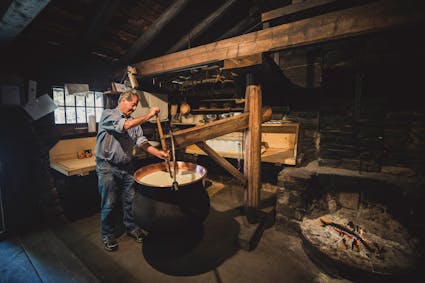Making cheese
The cheese dairy in Ballenberg functions on an almost daily basis. In House 1361, the Alpine Cheese Dairy from Kandersteg BE, visitors can not only look at the various bits of apparatus needed for cheesemaking but also follow the process itself as it happens. When the cheesemakers set to work the great copper cauldron begins to steam and bubble. Cheesemaking requires muscle power, know-how and patience. Those wishing to try out the result for themselves can buy fresh Ziger or a Ballenberg Mutschli. The cheesemakers at Ballenberg use old-fashioned methods, still partially in use today with the simplest means on swiss alpine pastures.

The basics of cheese-making
The basic rules of cheesemaking are still the same: firstly, the milk is heated to a temperature of 32°C. Then the rennet is added to the milk, as well as some cheese milk from the previous day. The milk curdles within 40 minutes. When the curdled milk is cut with the cheese harp the whey is separated from the granular curd. The cauldron is then placed over the fire again and the contents are stirred continually and heated to a temperature of 36°C. After about half an hour the cheesemaker lifts out the curd in a cloth and transfers it to wooden moulds. On the following day the Mutschli cheeses are placed in a salt bath and from then on they are lubricated and turned with water every day in the cheese storage area. They ripen in about four to five weeks. Ziger is made by reheating the cheese milk. The addition of milk vinegar brings about a second separating-out process. The watery liquid which is left over, the so-called ’Schotte’, is fed to the pigs which live at Ballenberg throughout the summer.
Ballenberg
Swiss Open-Air Museum
Museumsstrasse 100
CH-3858 Hofstetten bei Brienz
Opening hours
10 April to 2 November 2025
10 am to 5 pm daily